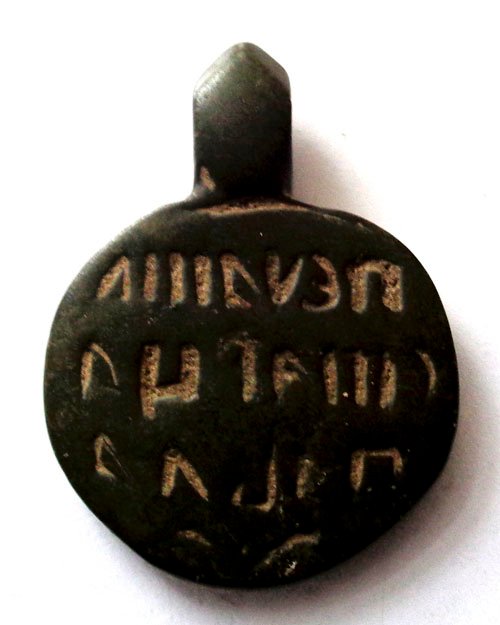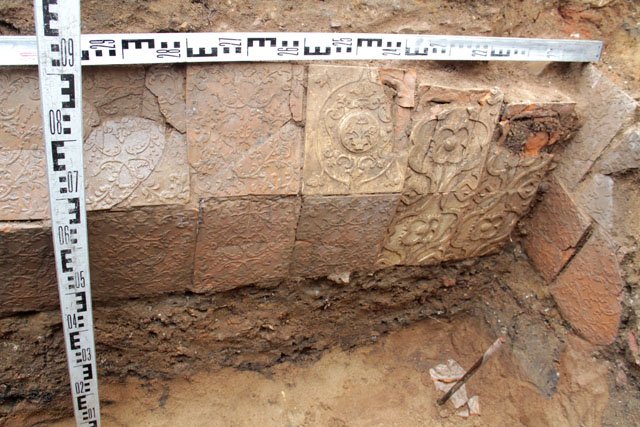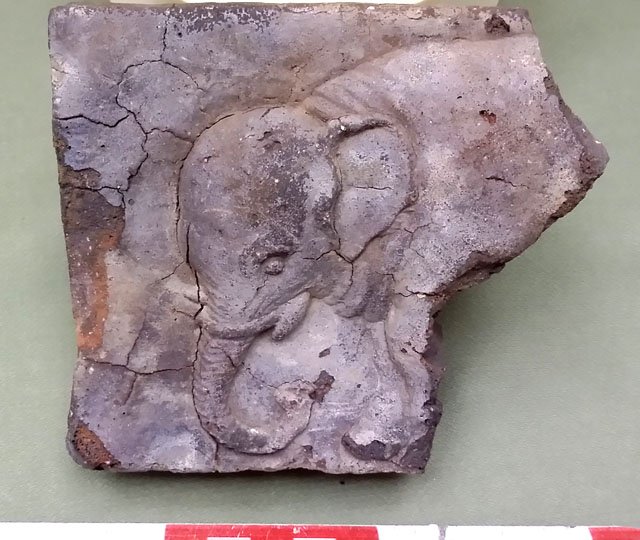From the latest discoveries of archaeologists IA RAS New findings in the New Jerusalem: Season 2016. This is very interesting, my dear Steemers!)
LA Belyaev, ON Glazunov, MA Kapitonov
The work of the New Jerusalem Resurrection Monastery in the expedition on the river. Istres related to its restoration, entered in 2016 in the final stage. Most of them are linked to the accompaniment of work on the infrastructure device. But in this, the land of the monastery brings unexpected findings during works on laying the networks and the reconstruction of South Fraternal housing. All of them, as before, talk about the culture of transition from the Middle Ages to modern times, that is, the links with Europe Muscovy.
Applied end of the XVII century print

Seal found in South fraternal body of the monastery territory, redeposited cultural layer. This disc-shaped copper alloy metal circle (diameter of about 1 cm) with a protruding rounded-faceted eye for suspension. One side is smooth, another embedded, smooth deep furrows, three rows of letters, forming when ottiskivanii clearly read the words: PRINT elders Paul. Each letter is individually cut, without ligatures or offsets. By letters simple sliced vegetable vignette type.
Personal seal with the inscription - not too common finding in the layers of the Moscow period, the monastery and the seals of the elders among them so far as we know, did not occur. Note the severity of registration: seal bears only the inscription, but not a symbolic image, a fairly typical for Late Medieval seals.
Since the New Jerusalem is well provided with written sources, it was possible to identify the identity of the owner of the print. "Paul" is named in the description of the Resurrection Monastery in 1679 among ordinary monks and elders. In the spiritual literacy Monastery Archimandrite Herman I († 11 December 1682), one of the first Russian poets, especially the person close to the Patriarch Nikon, referred to his cell-mate ( "Exclusionary offspring"), John, Peter, Paul and Andrew. Paul bequeathed "the image of Joseph, in the Psalms poldest yes podryasok sukonnoi sinei yes Alementar Polski Kievan Print". Last - is Elementar, ie primer, in this case - Polish, edition of the Kyiv-Pechersk Lavra. It is unlikely that he could bequeath to man, not who owned the language - the monk Paul, at least, taught Polish. Three years later, in the list of "Office of the elders" Inventory of the monastery in 1685, also indicated only Paul - baker (the position is not very high, but important in any hostel). Less than a decade in the account book of the monastery (1693), "the monk Paul" (not necessarily the same) Set bearing obedience "by the sea" on Ponoyskom fisheries (Tersk coast of the White Sea, p. Ponoy).
Thus it is possible, seal belonged to a monk, the ability to read in Polish, perhaps - came from Ukraine, Belarus, the less likely - Lithuania and Poland. On the stairs of the monastery service, he did not rise to the top positions (his career could be hampered with Herman's death), but has held responsible positions in practical terms. Since the responsibility of the bakers was to receive, store, holiday meal, and all the necessary for baking bread, his extradition to the tables, etc., he probably had to seal GEL, bags and storage.
New sfragistichesky sample application printing the elder, not only finds a place in the vast world of the post-Byzantine monastery Diplomatique (remember the great seals of Mount Athos). It is a strange way sheds light on the person of Archimandrite Herman, who comes from a family of clerics and prominent hymnography probably fallen into the New Jerusalem in the very young age (in New Jerusalem Monastery of the XVII century there was no private contributions and tonsure records). One might think that four of the lay brother. Herman were young people and students. And the fact that among them was a man reading in Polish, emphasizes creative communications hymnographic New Jerusalem mug (they still make up a puzzle) with the Polish tradition.
Crypt abroad XVII-XVIII centuries, lined with tiles

When working in the New Jerusalem burial, rather numerous, but assembled in a compact area, we do not open without the need for technical, they are trying to get. However, the installation of communication from time to time damaged the areas of cemeteries. It happened at work in the corner between the south-eastern wall of the narthex and the southern edge of the transition to underground churches, where on the eastern facade of the table placed tombstones from the beginning to the end of the XVIII century .: Archimandrite Anthony (1710-1722) and family Nashchokin (Daria M. + 1718; Ivan Nikiforovich (1718 sic);. Mikhail Ivanovich (+ 1722) and cast iron plate over the grave of Natalia Nikitichny by her husband Nashchokin (+ 1793) suddenly opened crypt damaged in the past, probably, in the construction of brick and stone collector . fences "Ground of the church" in the crypt are preserved in anatomical order the remains of the burial - but they caught our attention was that the crypt is paved entirely of relief terracotta (not irrigated) tiles with wall-sided backing Rump preserved: the southern wall of the eastern and.. west, as well as a number of tiles, neatly fallen from the ceiling facing the camera down. in a short distance from the top of the arch conceivable (virtually Rump shelygi) has in the past laid the foundation for tombstone, brick and white stone (nadgrobnitsa). Paul in the crypt, on the contrary, was not even provided. Masonry vault was carried out on the clay, probably without formwork: apparently, tiles obkladyvali as bricks, walls dug grave pit.
We are aware of one or two cases, when the graves are found tiles (krasnoglinyany headrest of the Trinity Lavra of St. Sergius, irrigation boards, tiles of the Sretensky Monastery), but no cases of these calculations of the crypt is still not met.
In this case, the tiles used as an ordinary brick or, taking into account their hollowness - as the vessels, resonators facing outward holes and face plates inside. Sure, it's specially designed consciously receive, having to maximize decorate the interior of the tomb, make it the most aesthetically pleasing, it is possible - to present on the walls of the image of "Garden of Eden". This is even more likely that the tomb selected tiles with floral ornaments, three types of intertwining branches and leaves ( "bosketny" type, the most numerous); the circular composition with a central medallion, topped with a crown (with a tulip flower with three stalks?); "Carpet" cartouches is very simple, even gruff figure with a pronounced relief (in the first two cases the relief exquisitely thin). Tiles of the second and third type are not equal, even with the number of tiles of the first; moreover, they have engobe (light yellow), while on the "bosketnyh" tiles it traces were detected. Tiles were not in the masonry, it is not spolia, but it's hard to think that they were prepared specifically for the vault - probably just took a series of previously harvested and the remains of the other, consisting of two types.
By itself, ornamentation - certainly of European origin. Chronologically, the vault should refer to the last stage of completion of the monastery with students Patriarch Nikon - can not be ruled 1690 - 1700s or the first quarter of the century (in the burial discovered pryamokonechny cross-vest, which can be dated, according to the engraving and inscriptions, most end of the XVII -XVIII centuries).
Will search for similar architectural solutions "ceramic coffins."
Tile with the image of an elephant

Since the early years of the New Jerusalem in a vast research complex tiles attracted attention with a series of images of animals, traced very realistic and in a classical manner. They emerged clearly as ceramic version of one of the new bestiaries, close to the scientific type, in the XVII century Europe already numerous. It should be noted that we are talking about the bestiary, because among the many exotic (antelope, camel) and not so exotic (wolf) living creatures mythical unicorn galloping briskly.
In 2016, this series has been completed with a fine example of an image of an elephant or a given proportion, rather elephant (found in the filling of one of the porches Southern fraternal body). Without going into the details of the symbolic value of the elephant in the historic emblems (this boundless region), we note the exceptional artistic quality, realism, detail of the execution of relief.
Congratulations @belgorogdmitriy! You received a personal award!
You can view your badges on your Steem Board and compare to others on the Steem Ranking
Vote for @Steemitboard as a witness to get one more award and increased upvotes!